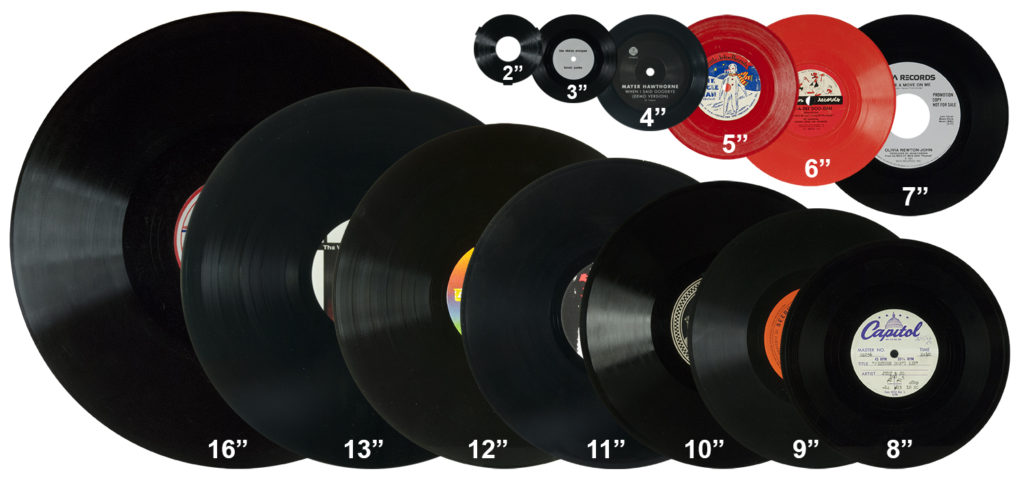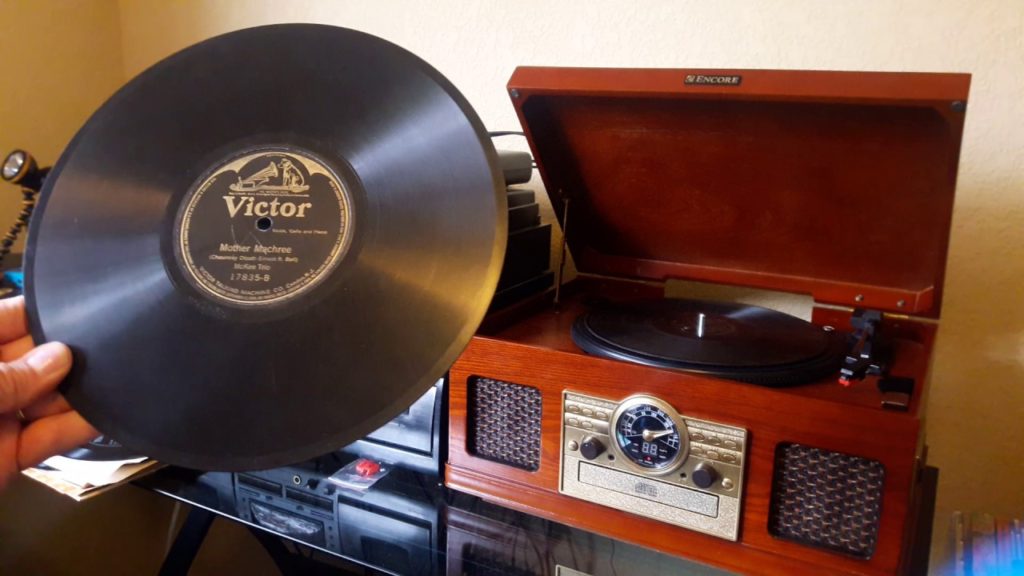Vinyl Record Sizes with Their Speeds –
What Does 33 – 45 - 78 RPM Mean?
If you are listening to music on your record player, the chances are that you are looking at a full-size 12-inch vinyl, and It must be spinning at 33-1/3 RPM. The second most popular is a 7-inch single that spins at 45 RPM. Many times artists use 12-inch records for producing EPs / full albums and 7-inch for singles. Vinyl records are available in different sizes and RPM capacities. Make sure you know about the classification before purchasing and playing them on your turntable. It needs to match the player’s configuration to the disk’s rotation limits. Otherwise, the vinyl may distort.
The following guide should help you learn about the different record sizes with their speeds
Standard Vinyl Record Sizes
Vinyl records are different in terms of their sizes based on the amount of music stored on their surface. There are three record sizes with their speeds sizes in which the disks are available:
- 12 inches
- 10 inches
- 7 inches
Sometimes records can become too cramped with grooves, and it may need to expand the size to add more music without compromising on audio quality. Otherwise, the slots will become too narrow to include all the detail of multiple audio records.

7-Inch Vinyl
The 7-inch single is the smallest of vinyl record sizes. As its size indicates, it doesn’t cost as much as the other more substantial sizes. The smaller size means that it also doesn’t hold as much music as a full-length disk.
A significant percentage of singles that transform into vinyl from music albums that are meant for CDs have unique cuts of songs that have been extended to 5-minute playtime. It is the typical time that a 7-inch record can hold.
10-Inch Vinyl
78 RPM is the least commonly found speed for disks, and artists mostly use it with 10-inch records. These records mainly were pressed before the 50s. You should worry about this extent only if you are a severe vinyl collector. Another reason could be if you have stumbled upon an old box of your grandfather that contains mostly 10-inch disks.
12-Inch Vinyl
It is the largest vinyl size with each side having a capacity to store up to a maximum of 22 minutes of audio. Thus, the most that a vinyl record can store is around 45 minutes of music. It may be much less if you compare it with modern media formats, but vinyl continues to have its exotic place in today’s homes.
Vinyl Weight
New albums are classified not just based on the size of the disk, but also their weight. Most of the time, the new collection from niche artists and independent labels tend to have high physical quality. They can deliver fantastic quality on even ordinary turntable and accessories.
Today, you can find albums being pressed on 180-gram records, making it a significant accomplishment. If you are a hardcore vinyl fan, you should have such a vinyl record in your collection.
- When the disk’s weight increase, the grooves become thicker
- The grooves deteriorate at a much slower pace compared to thin pressing
- You can use the record for much more times if you compare to the standard disk
It is essential to realize that the grooves are always going to degrade, no matter how thick the record is. In using a 180-gram vinyl, you will be able to slow down this process and enjoy the thrill of owning and playing your records for a more extended period. At the same time, it also retains the quality of music for a much more extended period.
Vinyl Records & Speeds
As already mentioned, you can also classify vinyl in terms of its speed. There are three standard speed sizes for records:
- 33-1/3 RPM
- 45 RPM
- 78 RPM
Find out how they are different from each other. Most record collectors will know what it is to flip speeds to hear music at different rates. Since it is possible to play vinyl at slower or faster speeds, what sense does it make to have disks that can run at various RPM? The technology available at the time of creating these disks has a lot to do with their playback speed.
Improving Playing Time Over the Decades
Over the decades of evolution of vinyl record, there has been a constant pursuit of improving audio quality. And this required improving the playing time.
- A slower turning record means worsening audio quality
- A record needs to turn faster, with higher RPM, to be able to produce better sound quality
- A faster turning record cannot hold the same amount of music as on a record that runs at a slower speed
- Faster running vinyl will have shorter playback times
- More music pressed on the vinyl gets read in a shorter period.
The following chronology should shed light on the development of vinyl records of different sizes.
Earliest Phonographs and their impact on records sizes with their speeds
Thomas Edison invented the first phonograph. It worked on a hand crank and thus had variable speed. It used to be cranked at a rate of 80 RPM and the vinyl cylinders used at the time could hold around 5 minutes of audio.
The first accurate disc record was ready in 1888 by Emile Berliner. It was based on an electric motor. Also, it played the record at speeds ranging from 70 RPM to 80 RPM.
78 RPM Records
Gradually more audio manufacturers emerged across the scene and began to produce turntables. Based on the early invention, 78 RPM record players became the standard. The players of the time used 3600 RPM motors, and their top performance was 78.26 RPM. Thus, 78 RPM became the official standard in the 1920s.

- These early disks had limits in their playback time, mostly to 3 minutes on a side
- They were made of a shellac material, brittle and could easily shatter
- The disc was available in a variety of sizes, with 10-inch becoming the most popular one
If you come across a 78 RPM record and fall in love with it, it is essential to have a turntable that can run that speed to be able to enjoy it. There are record players that support all the three rates and can play the standard 78 RPM disc as well.
33 RPM Records
When 78 RPM disks became popular and the widely accepted standard, new audio recording methods were being experimented and mastered. The focus was on pressing more audio information on smaller record sizes without compromising on fidelity. Soon record companies found that records that could play at 33 RPM were financially much more feasible.
- Smaller records were less likely to get scratches and other damages
- They were more affordable to press
- The popularity of 33 RPM records gradually stagnated with the emergence of radio
- Masses generally preferred listening to the radio than purchasing expensive records
- The 33 RPM record regained popularity in the late 1940s
- Columbia Records launched a 33 RPM record player with the ability to play both sides that didn’t need flipping the dish over.
45 RPM Records
RCA Records first introduced the 45 RPM record. The creation of the album was a result of the competition between companies to create new formats. This disc was smaller in size, and the release of this format was eventually a competitor to the 33 RPM disc from Columbia Record.
The early 45 RPM discs didn’t offer many advantages over the 78 RPM discs. But, by the early 1950s, they got value for their smaller size. At this time, more and more manufacturers started creating players that ran both 33 RPM and 45 RPM discs. And by the end of WWII, the more popular 78 RPM discs lost their charm.
While the 78 RPM disc was the fastest, there was a limitation on how much audio information a drive can play. Thus, the 78 discs seemed to be overkill, but the 45 made a lot of sense and continued to be in widespread use. However, you can still find 78s because there are still many avid fans.
Final Thoughts on records sizes with their speeds
All these three types of record sizes with their speeds contribute to the development of how consumers enjoy the audio. Some records have certain limitations depending on their manufacturing, and this affects their playback. So, all turntables can’t play 78 RPM discs. It requires special needles and configurations. So if you want to play all the different types of records, we suggest you choose a record player that can accommodate all of them.
